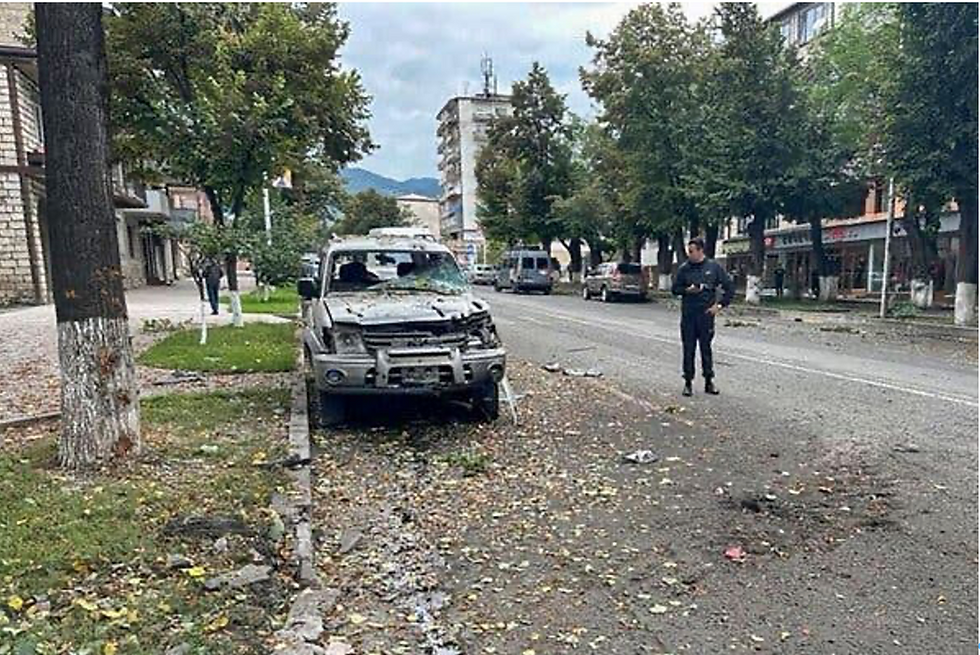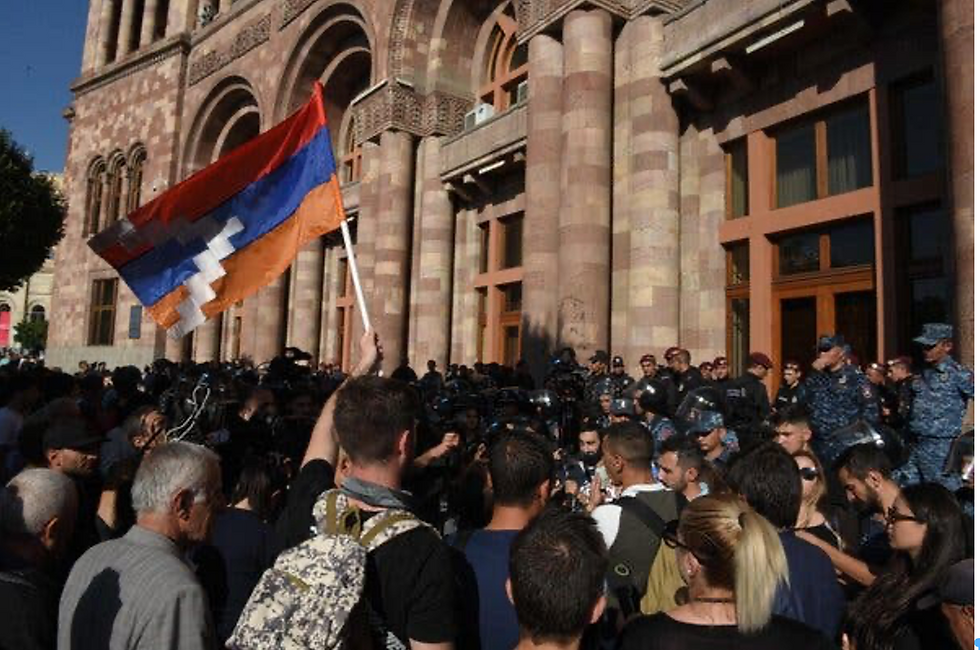What Future do Armenians Have in Nagorno-Karabakh?
- Genocide Watch

- Sep 20, 2023
- 4 min read
After Surrender in Nagorno-Karabakh, Leaders Discuss Armenians’ Fate
The New York Times
Sept. 21, 2023
Reporting from Yerevan, Armenia
One day after Azerbaijan used force to assert its authority over Nagorno-Karabakh, a mountainous region in the South Caucasus, its officials met with representatives of the pro-Armenian enclave on Thursday to discuss the future of the residents there under new rule.
Escorted by Russian peacekeepers, a delegation of the government of Nagorno-Karabakh arrived in the town of Yevlakh in Azerbaijan to meet with representatives of the Azerbaijani government.
Officials of the region met with representatives of Azerbaijan to talk about the future of its residents, many of whom strongly resist the idea of coming under Azerbaijani rule.
Azerbaijan’s brisk military recapture of Nagorno-Karabakh — a strategic slice of land slightly bigger than Rhode Island that is internationally recognized as part of Azerbaijan — could further alter power dynamics in the combustible region where interests of Russia, Turkey and Western states collide.
Azerbaijan’s victory also posed a humanitarian challenge for tens of thousands of Armenians living there. Citing multiple historic grievances, many Armenians have been adamantly opposed to coming under Azerbaijani rule.
And while President Ilham Aliyev of Azerbaijan, in an address on Wednesday, promised to create “a paradise” for Armenians in Karabakh who could “finally breathe a sigh of relief,” few were persuaded by a message coming from the leader of a nation many Armenians see as bent on destroying them.
“The biggest problem now is what to do with the many displaced people who cannot return to the villages that were captured by Azerbaijan,” said Olesya Vartanyan, an analyst who assesses the region for the International Crisis Group.
She said there were thousands of people in Nagorno-Karabakh who cannot decide what to do: hide in their basements, stay at Russian peacekeeping bases and observation points, or try to flee the region. “People are in panic and the humanitarian situation there is horrendous,” she said.
The shift in control also raised serious questions about the apparent waning of Russia’s influence in the region.
Following a 44-day war in 2020, in which Azerbaijan recaptured much of its land, Russia sent about 2,000 peacekeepers to monitor the situation and prevent ethnic clashes. But lacking a clear mandate, peacekeepers could not prevent a new stage of fighting that flared over the summer and culminated in this week’s Azerbaijani victory.
Authorities in the breakaway government reported on Thursday that at least 200 people had died in the fighting, including 10 civilians; the rest were army servicemen. Those figures could be independently verified.

A photograph released by the Nagorno-Karabakh human rights ombudsman on Wednesday showed a damaged car in the Nagorno-Karabakh region. Authorities there said at least 200 people had died in the fighting.Credit...Artsakh/Nagorno-Karabakh Human Rights Ombudsman/EPA, via Shutterstock
Separately, the Russian defense ministry reported that several of its peacekeepers were killed on Wednesday when their car came under small-arms fire as they returned from an observation point in Nagorno-Karabakh.
Thousands of people gathered on Wednesday evening on the main square of Yerevan, the capital of Armenia, to urge their government to intervene. Prime Minister Nikol Pashinyan of Armenia has been trying to distance his government from the conflict.
To many protesters, Mr. Pashinyan’s approach was a sign of betrayal. They chanted “Arstakh!” — the Armenian name for Nagorno-Karabakh — and called for Mr. Pashinyan to be arrested. Some protesters blocked streets leading to the square and a group of them attacked the main government building. But in interviews, people seemed resigned to the idea that Nagorno-Karabakh might be lost, even if not forever.
A smaller crowd in front of the Russian embassy in Yerevan demanded that Moscow take a more assertive stance. The string of defeats has forced many in Armenia to reconsider the traditional view that Moscow was the country’s main protector.
“We cannot simply rely on others to defend us,” said Rebecca, a 65-year-old protester, who declined to give her last name for fear of repercussions. Standing in front of the government building, she said that she “cannot accept” that Nagorno-Karabakh would be lost forever.
“A miracle must happen,” she said.
In recent years, Mr. Pashinyan has been distancing Armenia, a part of a Russia-led security alliance, from Moscow. This month the Armenian government decided to start the process of ratification of the Rome Statute — which could eventually require it to arrest President Vladimir V. Putin under a warrant from the International Court of Justice if he stepped on Armenian soil.

Protesters in Yerevan, Armenia, on Wednesday, urging the government to intervene in the Nagorno-Karabakh region. To many protesters, the prime minister’s approach was a sign of betrayal. Credit...Karen Minasyan/Agence France-Presse — Getty Images
Anna Hakobyan, Mr. Pashinyan's wife, made a visit to Ukraine this month, meeting with President Volodymyr Zelensky. Armenian army servicemen conducted drills with American soldiers in the same month.
All of that prompted anger in Moscow, which summoned the Armenian ambassador to express its displeasure with “a number of unfriendly steps.”
Azerbaijan’s victory also came at a time when Moscow is distracted by its invasion of Ukraine and is unable to use political and military resources in two regions at once.
The conflict between Armenians and Azerbaijanis flared at the end of the 1980s as the Soviet Union was weakening. Two nations that lived as friendly neighbors for decades, with their children sharing meals and playing together, suddenly turned into archenemies, taking up arms against each other and engaging in pogroms.
A bloody war ended with Armenia emerging victorious in 1994, capitalizing on Azerbaijan’s internal political chaos. The war produced hundreds of thousands of refugees as Armenians fled Azerbaijan and Azerbaijanis fled Armenia, as well as areas around Nagorno-Karabakh that were captured by the Armenian forces.
Backed by Turkey and its oil and gas wealth, Azerbaijan was able to gradually rebuild its army and eventually defeat Armenia in 2020. A cease-fire brokered by Moscow was signed, and tens of thousands of Armenians concentrated in the last remaining slice of disputed land, Nagorno-Karabakh.
Over the past year, mindful of Russia’s distraction in Ukraine, Azerbaijan continued to increase its footprint in the area, eventually blocking the only road that linked Nagorno-Karabakh with Armenia.
Its residents have been essentially sealed off from the outside world, leading to severe food and fuel shortages, difficulties with medical care and other humanitarian hardships, leading to accusations of genocide.
Ivan Nechepurenko has been a Times reporter since 2015, covering politics, economics, sports and culture in Russia and the former Soviet republics. He was raised in St. Petersburg,
Copyright 2023 The New York Times Company






